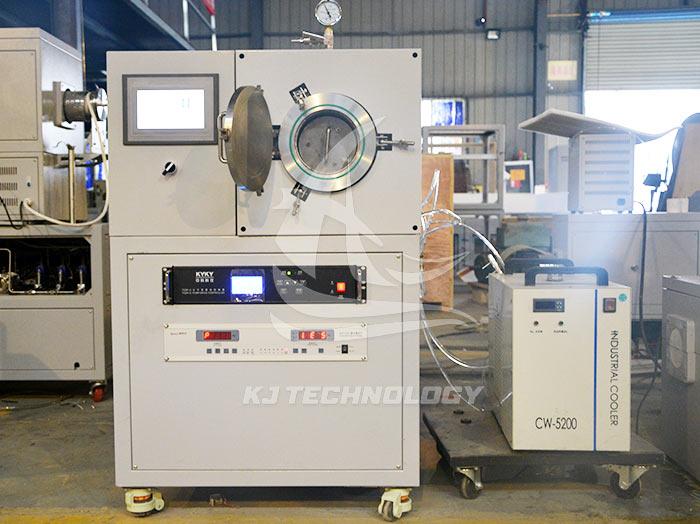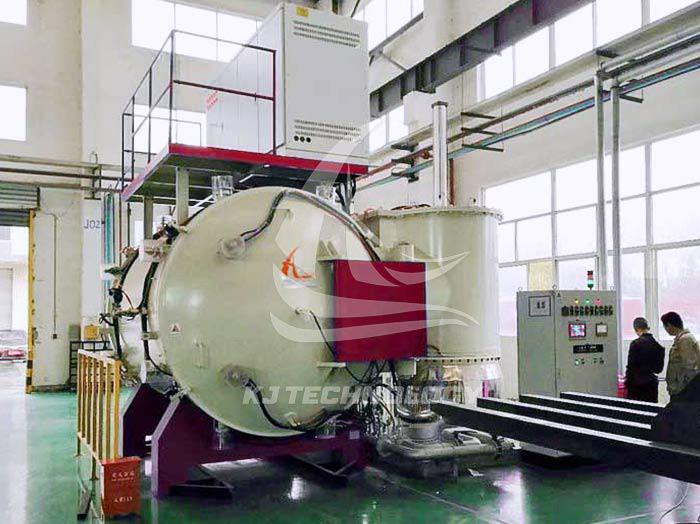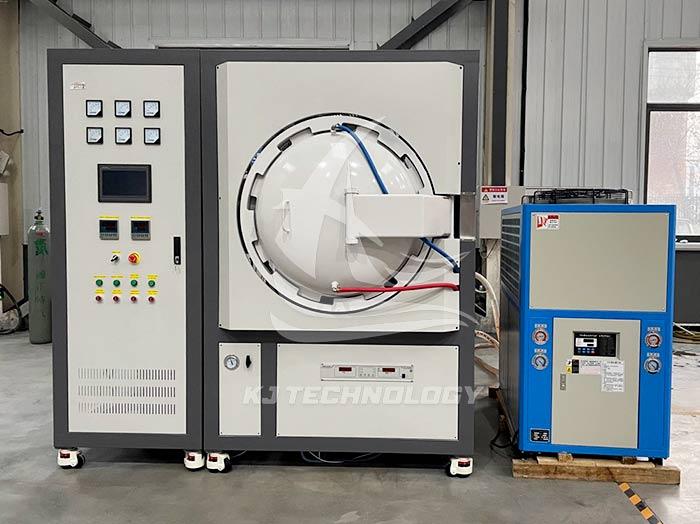Electric heating vacuum heat treatment furnace
 08-14-2025 Author: KJ technology
08-14-2025 Author: KJ technology
Electric Heating Vacuum Heat Treatment Furnace: Technical Analysis, Application Scenarios, and Operating Specifications
1. Technical principles and core advantages
The electric heating vacuum heat treatment furnace reduces the pressure inside the furnace chamber to below 10 ⁻ Pa through a vacuum system (vacuum pump, valve, measuring device), combined with resistance heating, induction heating, or electron beam heating technology, to achieve heat treatment of metal materials in a non oxidizing and non polluting environment. Its core advantages include:
Non oxidative decarburization: The vacuum environment isolates oxidizing gases such as oxygen and water vapor, avoiding the formation of oxide films or decarburization layers on the surface of the workpiece and maintaining the original properties of the metal. For example, heating titanium alloy in an air furnace can easily generate hydrides, leading to increased brittleness, while vacuum treatment can completely avoid this problem.
High surface smoothness: The vacuum environment promotes the decomposition and evaporation of impurities such as grease and emulsion on the surface of the workpiece. After being extracted by a vacuum pump, the surface roughness of the workpiece can be reduced to below Ra0.2 μ m without the need for subsequent polishing.
Small deformation and high qualification rate: The radiation heating method reduces the thermal temperature difference inside the workpiece, lowers thermal stress, and reduces deformation by more than 50% compared to traditional processes. For example, when processing H13 mold steel, single piece insulation for 90 minutes is sufficient, and it can be extended to 120 minutes when fully loaded, still ensuring dimensional accuracy.
Energy saving and environmental protection: The thermal efficiency reaches over 95%, which is 30% more energy-efficient than traditional furnace types; No emissions of exhaust gas or wastewater, meeting the requirements of green manufacturing.
2. Application scenarios and typical cases
aerospace field
Solid solution aging treatment of high-temperature alloy blades: uniform heating at 1200 ℃ is achieved through a vacuum furnace to improve creep resistance and extend engine life.
Heat treatment of titanium alloy components: Vacuum environment is used to prevent surface hydrogen embrittlement, ensuring that the vacuum degree of TC4 titanium alloy parts remains stable below 10Pa at 650 ℃, and avoiding excessive alpha layer.
Semiconductor Manufacturing
Silicon wafer diffusion and oxidation: Vacuum furnace provides a clean environment, reduces impurity pollution, and improves integrated circuit yield.
Microelectronics device brazing: Vacuum brazing technology is used to achieve high-precision seamless connection, meeting the reliability requirements of 5G communication equipment for devices.
Powder metallurgy field
Hard alloy sintering: The vacuum sintering process can prepare hard alloy parts with a density of up to 99%, increasing hardness by 15% and significantly enhancing wear resistance.
Preparation of nanomaterials: Vacuum environment promotes uniform growth of nanoparticles, avoids agglomeration, and improves material properties.
automotive industry
Mold steel quenching: The dual chamber high-pressure gas quenching vacuum furnace achieves part quenching by rapidly filling inert gas, resulting in better uniformity of structure than oil quenching and an increase in mold life by more than 30%.
Vacuum welding of radiators: suitable for welding plate or tube heat exchangers such as automotive radiators and air conditioning evaporators, with high weld strength and no risk of leakage.
3. Operating standards and safety points
Pre startup inspection
Sealing system: Check if the O-ring of the furnace door is intact to avoid a sudden drop in vacuum caused by a gap in the sealing strip. For example, a certain factory caused a 0.5mm wide gap in the sealing strip, resulting in the surface alpha layer of the entire furnace workpiece exceeding the standard by 3 μ m.
Cooling water system: Ensure a flow rate of ≥ 25m ³/h and a stable pressure of 0.3-0.5MPa to prevent deformation of the furnace shell due to heating.
Fixtures: The load-bearing components should be made of molybdenum alloy to avoid creep deformation of 316L stainless steel brackets at 1320 ℃.
Process parameter setting
Vacuum degree control: divided into three levels of step-by-step management, maintaining 10Pa from room temperature to 600 ℃, and reaching below 6 × 10 ⁻ ² Pa in the high temperature section. If the pressure is higher than 5 × 10 ⁻¹ Pa, decarburization spots will appear on the surface of M2 high-speed steel.
Temperature uniformity: When the furnace loading exceeds 70% of the effective volume, the temperature deviation expands to ± 15 ℃, and the insulation time needs to be extended to compensate.
Safety protection measures
Nitrogen filling and air breaking process: The furnace door can only be opened when the oxygen content analyzer value is ≤ 0.5% to prevent flash explosion accidents.
Quenching oil tank monitoring: Set up dual warning lines, trigger a secondary alarm when the oil level is below 85% of the volume, to avoid fire caused by high oil temperature.
Personal protection: When handling beryllium copper alloy, it is necessary to wear a positive pressure gas supply helmet. Ordinary gas masks cannot block 0.5 μ m level metal aerosols.
Emergency response process
Abnormal shutdown of mechanical pump: The Roots pump needs to be started within 8 minutes to maintain vacuum and prevent oxidation of workpieces in the furnace.
Cooling water interruption: Start the backup water source within 3 minutes, and emergency nitrogen filling must be performed after 5 minutes to avoid intergranular corrosion of the IN718 turbine disk.
4. Maintenance and Data Traceability
Routine maintenance
Pump oil replacement: When the ultimate vacuum degree drops by 20% or the water content exceeds 300ppm, it is forced to replace to ensure the pumping efficiency.
Cleaning of the diffuser: A carbon deposition thickness of 1mm can reduce thermal efficiency by 18%, and regular cleaning is required to maintain performance.
Data recording and analysis
Traceability of heating curve: Record the complete heating curve for each furnace, providing a basis for analyzing the abnormal precipitation of δ phase in GH4169 alloy.
Energy consumption statistical analysis: Optimize process parameters and reduce production costs through quarterly energy consumption data.
5. Technological development trends
Intelligent upgrade: AI algorithm optimizes heating curve in real time, digital twin technology achieves fault prediction, and improves equipment reliability.
Energy efficiency improvement: Graphene heating elements increase thermal efficiency to 95%, and waste heat recovery systems reduce energy consumption by 30%, in line with carbon neutrality goals.
Multi functional integration: Integrating composite functions such as plasma cleaning and ion nitriding to meet complex process requirements and expand application areas.








